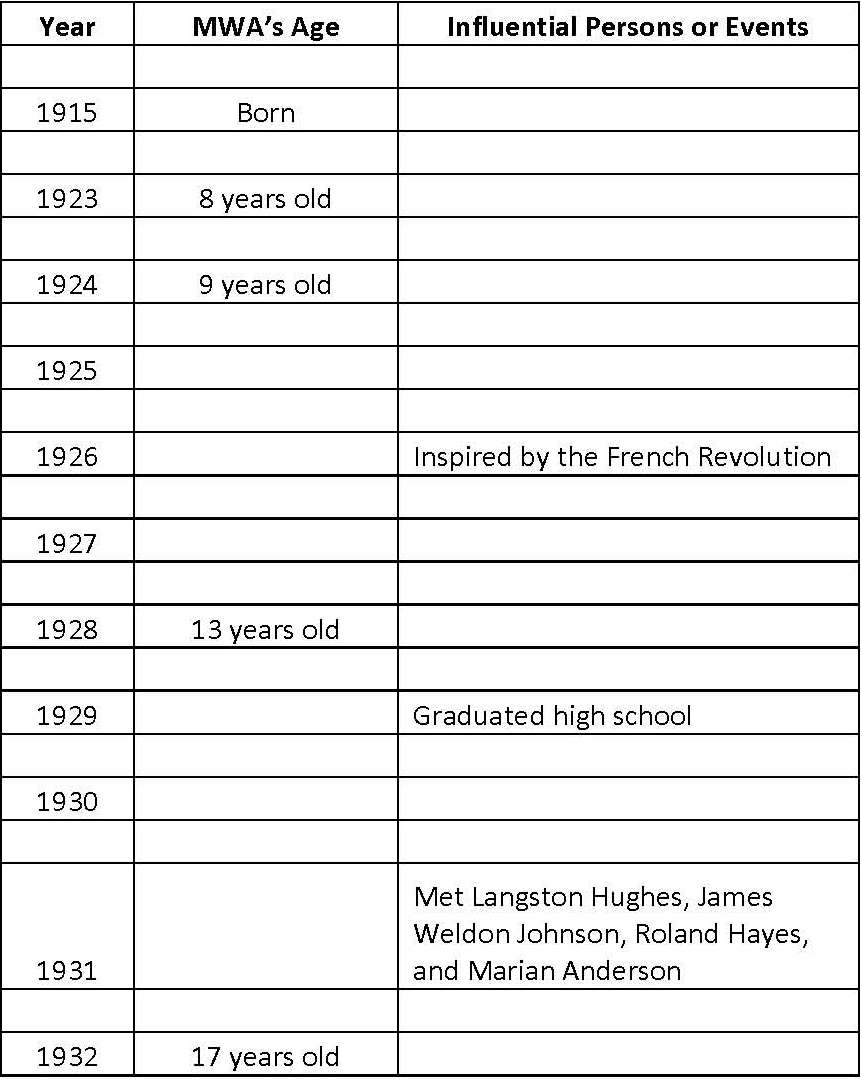Grades: 9-12
Author: Vija L. Lee, Jackson, Mississippi
OVERVIEW
After viewing Margaret Walker’s personal journals, students will learn that she kept a diary from the age of twelve in 1927 until her death in 1998. By examining some of her journal entries, one can witness the art and benefit of reflective writing. Students will be asked to read and discuss Walker’s reflections and begin their own journey through the art of journaling.
MATERIALS NEEDED
Computers
Notebooks or folders prepared to keep on-going journals
OBJECTIVES
Students are frequently unmotivated or unable to develop a passion for writing. This is primarily due to most students’ regard for writing as being difficultt or only necessary in the academic world. In helping students realize how Margaret Walker’s journal writings benefited her, especially through self-reflection, they can see how expressing their own thoughts, feelings, beliefs, and daily activities through journaling can help them stay organized and meditate on their own journeys.
Through this process, students will:
- Identify elements of and various types of journals;
- Reflect on personal experiences and create their own journals;
- Compare and contrast some of their experiences to Margaret Walker’s; and
- Explore the Margaret Walker Center’s Digital Archives Project.
SESSION 1
- Ask students to write a description of their own passions and dreams. Suggest that they describe why and how they are pursuing their passions and dreams. Also discuss positive influential factors such as people who have helped develop their dreams.
- Teachers should state that this entry will be each student’s first entry in an on-going journal that will be kept in class. Teachers must decide on the process for developing writing sessions in class and creating methods and opportunities for sharing.
- Next, the teacher should introduce various types of journals, the reasons and benefits of journal writing, and information on Margaret Walker’s life.
- Before reading the Journal 90, page 115 aloud, tell students that they will be asked to write a few sentences describing Walker’s passion for writing and keeping a journal. Also, they are encouraged to discuss any similarities they may have with her dreams and passions.
- Teachers should distribute a handout of the following timeline.
- Instruct students that the chart should be completed after the teacher reads the journal entry aloud as the students read along.
- The teacher should assist students in filling in the blanks according to the journal entry detailing how Walker began her writing career. Teachers should point out how the writer is reflecting later in life on how she began writing.
- Allow five to ten minutes for students to continue to write their first journal entry about Margaret Walker’s beginnings as a writer and how it relates to their own passions and dreams.
SESSION 2
- Begin by asking students to review their journal entry written in the last class and to add new thoughts they have today. The teacher should stress that writing is never truly complete. It is always a work in progress whether it is in a personal or an academic setting.
- Ask students to voluntarily share their journals or comments about reflective writing.
- For five to ten minutes have students write in their journals about the following question:
Have you ever said something for someone else to hear and wish you could rephrase it or not have said it at all? Tell about an experience when this has occurred.
- Have the students read the lines below taken from Margaret Walker’s Journal 32, page 8, and discuss the question that follows:
Journal 32, page 8 (October 1948)
“The spirit of prosperity and success has already entered my affairs and my visible supply is increased.”
“The spirit of prosperity and success has entered into my affairs and my whole visible supply is abundantly increased.“
Margaret Walker took the time to revise the second statement after originally writing the first. What can you infer about her as a writer?
- Give students 5-10 minutes to continue their journal their second journal entry on how keeping a journal can help an individual with his or her emotions and beliefs while being reflective and precise with their words. How does this relate to the given topic, which began your journal entry today?
SESSIONS 3 AND 4
- Begin by asking students to review their journal entries from the last class and to jot down any new thoughts they may have today. Again, you should remind students that writing is never truly complete. It is always a work in progress whether it is in a personal or an academic setting.
- Ask students to voluntarily share their journals or comments about reflective writing.
- For five to ten minutes have students write in their journals about one of the following “Golden Lines” from Margaret Walker’s journals:
Journal 32, page 4 (September 1948)
If my work could sell me as my tongue and personality I would be all right.
Journal 47, page 17 (March 1954)
I am growing very discouraged about my writing. Maybe I do not have it in me any longer if I ever did. I am almost ashamed to show my writing for fear it will not be any good. But I must.
ASSESSMENT
The teacher should decide how to create incentives and opportunities for the students to write. Although teachers may wish to develop a grading rubric for this lesson, they should be wary of giving poor grades that might deter students from writing on their own.
 Skip to main content
Skip to main content


